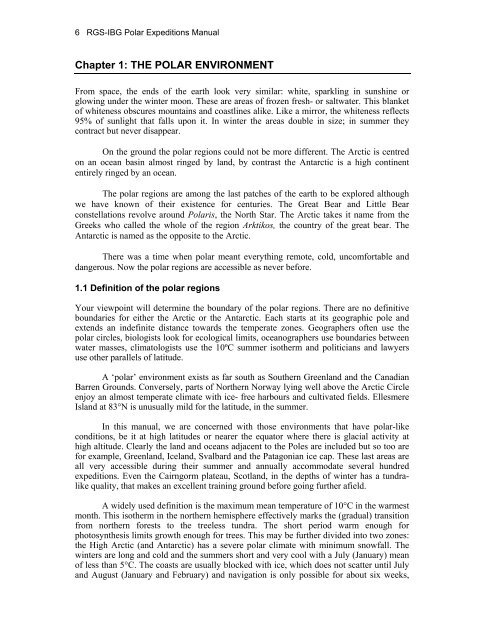Edited by Rachel Duncan 4th Edition ISBN 0-907649-91-2 London ...
Edited by Rachel Duncan 4th Edition ISBN 0-907649-91-2 London ...
Edited by Rachel Duncan 4th Edition ISBN 0-907649-91-2 London ...
Create successful ePaper yourself
Turn your PDF publications into a flip-book with our unique Google optimized e-Paper software.
6 RGS-IBG Polar Expeditions Manual<br />
Chapter 1: THE POLAR ENVIRONMENT<br />
From space, the ends of the earth look very similar: white, sparkling in sunshine or<br />
glowing under the winter moon. These are areas of frozen fresh- or saltwater. This blanket<br />
of whiteness obscures mountains and coastlines alike. Like a mirror, the whiteness reflects<br />
95% of sunlight that falls upon it. In winter the areas double in size; in summer they<br />
contract but never disappear.<br />
On the ground the polar regions could not be more different. The Arctic is centred<br />
on an ocean basin almost ringed <strong>by</strong> land, <strong>by</strong> contrast the Antarctic is a high continent<br />
entirely ringed <strong>by</strong> an ocean.<br />
The polar regions are among the last patches of the earth to be explored although<br />
we have known of their existence for centuries. The Great Bear and Little Bear<br />
constellations revolve around Polaris, the North Star. The Arctic takes it name from the<br />
Greeks who called the whole of the region Arktikos, the country of the great bear. The<br />
Antarctic is named as the opposite to the Arctic.<br />
There was a time when polar meant everything remote, cold, uncomfortable and<br />
dangerous. Now the polar regions are accessible as never before.<br />
1.1 Definition of the polar regions<br />
Your viewpoint will determine the boundary of the polar regions. There are no definitive<br />
boundaries for either the Arctic or the Antarctic. Each starts at its geographic pole and<br />
extends an indefinite distance towards the temperate zones. Geographers often use the<br />
polar circles, biologists look for ecological limits, oceanographers use boundaries between<br />
water masses, climatologists use the 10ºC summer isotherm and politicians and lawyers<br />
use other parallels of latitude.<br />
A ‘polar’ environment exists as far south as Southern Greenland and the Canadian<br />
Barren Grounds. Conversely, parts of Northern Norway lying well above the Arctic Circle<br />
enjoy an almost temperate climate with ice- free harbours and cultivated fields. Ellesmere<br />
Island at 83°N is unusually mild for the latitude, in the summer.<br />
In this manual, we are concerned with those environments that have polar-like<br />
conditions, be it at high latitudes or nearer the equator where there is glacial activity at<br />
high altitude. Clearly the land and oceans adjacent to the Poles are included but so too are<br />
for example, Greenland, Iceland, Svalbard and the Patagonian ice cap. These last areas are<br />
all very accessible during their summer and annually accommodate several hundred<br />
expeditions. Even the Cairngorm plateau, Scotland, in the depths of winter has a tundralike<br />
quality, that makes an excellent training ground before going further afield.<br />
A widely used definition is the maximum mean temperature of 10°C in the warmest<br />
month. This isotherm in the northern hemisphere effectively marks the (gradual) transition<br />
from northern forests to the treeless tundra. The short period warm enough for<br />
photosynthesis limits growth enough for trees. This may be further divided into two zones:<br />
the High Arctic (and Antarctic) has a severe polar climate with minimum snowfall. The<br />
winters are long and cold and the summers short and very cool with a July (January) mean<br />
of less than 5°C. The coasts are usually blocked with ice, which does not scatter until July<br />
and August (January and February) and navigation is only possible for about six weeks,

















